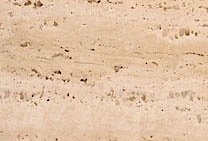Red Sandstone Exterior Cladding NASA Johnson Space Center Building 21, Houston, TX Reminiscent of an Southwestern Desert skyline, Red Sandstone can be found all over the world in desert and dry areas. Colored by Iron oxide, Red Sandstone has a neutral warm red color. Red sandstone makes for great exterior cladding due to […]
Guide to StonePly Lightweight Travertine Panels for Stone Cladding and Wall Panels
A Guide for Selection, Design, and Installation of Reinforced Travertine for Cladding, Curtain Wall, Elevators and Wall Panels
Travertines are one of the more popular stones for cladding applications. The pitted and layered appearance has been attractive to designers and architects since ancient times. Travertines have a stratified appearance as they are formed by the overlapping of horizontal stone layers. The stone has a number of small holes more or less parallel to the direction of the bedding layers. Travertine is prized as a wall cladding for its undulating layered pattern of bedding and its natural voids. The layered appearance is accentuated by the pitting which varies in size and frequency. Italy is source for the best known varieties of travertine, but travertines are also quarried in Mexico, Turkey and elsewhere around the world.
Italian White Travertine or Travertine Bianco is the primary white travertine quarried in Italy. Due to the small number of quarrying areas and their limited production, the availability of white travertine varieties for exterior or interior cladding projects can be fairly limited. Thanks to the efficiency of the StonePly process, more cladding can be produced with less stone and that helps ensure an adequate supply of travertine for any sized project. Other travertines include Silver, Walnut, Golden and Roman.
Quarry blocks from the travertine quarries are generally medium-sized. From these blocks StonePly panels are produced as 4′ by 8′ panels or in sizes custom produced for your application. The travertine face of the StonePly panels is typically 1/4″ thick with a backing of either 1/2″ or 3/4″ aluminum honeycomb. The panel weight is around 3.4 lbs per sq ft. For some special applications a fiberglass backing or an aluminum composite backing can be used. The StonePly travertine on aluminum honeycomb cladding panels offer 60 times the impact strength of ordinary travertine, are able to resist hurricane force winds, large missile impact testing and seismic racking.
Applications
Travertine StonePly panels are suitable for cladding and wall panels for both interiors and exteriors. Despite the pitting, travertine is surprisingly resistant to freeze thaw and StonePly’s travertine cladding panels are suitable for use in freezing weather and appropriate for all climates. Ordinary travertine panels are porous to water and, when used as a cladding, they can leak rain into the wall cavity. StonePly travertine panels have a solid sheet of aluminum behind them that makes them impervious to the passage of moisture.
The surface of travertine wall panels and cladding is generally either polished or honed. When used as a flooring, travertine should be filled to avoid dirt collecting in the voids. This can be done at the factory and involves filling the voids with a resin and stone powder or a cementitious stone filler.
Testing and Standards for Travertine Panels
StonePly travertine panels are tested to various standards including UL, ASTM standards and ICC/IRC or IBC (International Building Code) standards. Testing has also been done to confirm compliance with the International Residential Code and International Fire Code standards.
StonePly also offers extensive testing data to Canadian standards. For our European clients, StonePly offers testing to UK (BS), Italian, European Standards and other testing standards. Engineering is available for the panels and their attachments for cladding, curtain wall or other applications.
Some of the ASTM standards and specifications that apply to travertine cladding include:
ASTM 330-02 Standard Test Method for Structural Performance of Curtain Walls
ASTM E1996-05B Specifications for Performance of Impact Protective Systems Impacted by Windborne Debris in Hurricanes
ASTM C1527 / C1527M-11Standard Specification for Travertine Dimension Stone
ASTM C97/C97M Test Methods for Absorption and Bulk Specific Gravity of Dimension Stone
ASTM C99/C99M Test Method for Modulus of Rupture of Dimension Stone
ASTM C119 Terminology Relating to Dimension Stone
ASTM C170/C170M Test Method for Compressive Strength of Dimension Stone
ASTM C241/C241M Test Method for Abrasion Resistance of Stone Subjected to Foot Traffic
ASTM C1528 Guide for Selection of Dimension Stone
Large Missile Impact Testing: Large missile impact tests involve firing a weighted 2 X 4 at the stone cladding panel. The test simulates the impact of large windborne debris, such as wood framing, tree limbs, posts and other large objects. The test involves impact followed by severe pressure cycling. The StonePly panel passed, while the ordinary stone slab control was broken and failed.
Small Missile Impact Testing: The small missile impact test simulates smaller wind-borne debris, such as hail or roof gravel. The cladding panel must resist windborne debris followed by severe pressure cycling.
Testing information is available here.
In architectural specifications, StonePly Travertine Cladding may be specified under:
SECTION 07420 NATURAL STONE REINFORCED PANELS (EXTERIOR)
SECTION 09452 NATURAL STONE REINFORCED PANELS (INTERIOR)
These specifications are available here.
If your project involves travertine cladding, wall panels, travertine elevator panels or other applications where a super strong, lightweight and easy to install travertine panel would be appropriate, contact us. Our specialists are available to help you with details, pricing, specifications or other questions you may have.

No comments yet.